Muscle Spasmaccording to TCM
Symptom family: Muscle Spasms and Twitching
Sub-symptom(s): Extremity Spasms Gastrocnemius Muscle Spasm Spasm Of The Masseter Muscle Extremities Spasms Hand Spasm Muscle Spasm Pain
Did you mean? Muscle Cramps
What is Muscle Spasm?
Muscle spasm, also known as spasmodic movement or tetanic contractions, refers to sudden and involuntary muscle contractions that can cause discomfort and limited mobility. This condition can manifest in various forms, including extremity spasms, hand spasms, or spasms of specific muscles like the gastrocnemius or masseter.
Individuals experiencing muscle spasms may feel tightness, cramping, or a sensation of knots in the affected muscles, often resulting from overuse, dehydration, or underlying medical conditions.
How Does TCM View Muscle Spasm?
In Traditional Chinese Medicine (TCM), muscle spasm is perceived as a disruption in the body's flow of Qi (vital energy) and Blood circulation, leading to Stagnation and disharmony within the Channels. TCM practitioners attribute muscle spasms to patterns of disharmony such as Qi and Blood Stagnation, as well as external factors like Summer Heat invading the body.
Rather than solely addressing symptoms, TCM focuses on identifying the root cause of muscle spasms, which can vary among individuals based on their unique constitution and health status.
Root Causes of Muscle Spasm in TCM
TCM identifies various patterns of disharmony that may contribute to muscle spasms. One common cause is Summer Heat invading the Lesser Yin and Terminal Yin warps, characterized by symptoms such as muscle spasms, thirst, and restlessness.
Another cause is Qi Deficiency, which may lead to insufficient nourishment and support for the muscles, resulting in spasmodic movement. Treatment in TCM aims to address these underlying imbalances through herbal remedies and acupuncture, tailored to each individual's specific pattern of disharmony.
Explore below more details about what might cause Muscle spasm according to TCM.
- By Syndrome
- By Organ
- Yang Excess
- Summer Heat
- Wind
- Liver
Yang Excess
Yang Excess in TCM refers to a state where there is an overabundance of Yang energy, leading to symptoms of heat and hyperactivity in the body. This pattern of disharmony often arises from factors like stress, excessive physical activity, overconsumption of spicy or heating foods, or an internal imbalance that causes Yang to flare up. Symptoms of Yang Excess include a feeling of heat, red face, irritability, restlessness, thirst, constipation, and a rapid, forceful pulse. Treatment in TCM for Yang Excess aims to cool down and subdue the excessive Yang while nurturing Yin energy to restore balance.... see more
Yang Excess Patterns That Can Lead to Muscle Spasm
| Pattern Name | Relevant Symptoms | Relevant Formulas |
|---|---|---|
| Liver Wind agitating Internally due to Liver Yang Rising | Spasms in the extremities, Tremors, Facial tic, Severe dizziness, Tinnitus, Headaches, Hypertension, Dry throat, Dry eyes, Blurry vision, Limb numbness, Tingling of limbs, Poor memory, Back pain, Oliguria, Night sweats... see more | Tian Ma Gou Teng Yin |
Summer Heat
"Summer-Heat" in TCM is a unique concept that refers to a pattern of disharmony often associated with the hot summer months. Imagine the intense heat of summer stressing your body, like being in a sweltering, humid environment for too long. This can lead to symptoms like feeling overheated, excessive sweating, a feeling of irritation, and sometimes even nausea or dizziness. In TCM, this condition is thought to arise from the external environment's heat affecting the body's internal balance. It's similar to how we might feel uncomfortable and out of sorts on a very hot day. ... see more
Summer Heat Patterns That Can Lead to Muscle Spasm
| Pattern Name | Relevant Symptoms | Relevant Formulas |
|---|---|---|
| Summer-Heat entering the Lesser Yin and Terminal Yin warps | muscle spasms, Wasting, Thirst, Cardiac burning sensation, Irritability, Restlessness, Paralysis, Loss of consciousness, Mental disturbances, Muscle numbness, Muscle spasm... see more | Wu Shi Lian Mei Tang |
Wind
In TCM "Wind" is a concept that represents a pattern of disharmony, often characterized by its sudden and unpredictable nature, much like a gusty wind changing direction without warning. This pattern is associated with symptoms that come and go quickly or move around the body, such as itching, tremors, or even certain types of pain. Wind is considered to be a primary cause of illnesses that have these rapidly changing characteristics. In TCM, external Wind often refers to illnesses that start suddenly, like the common cold, believed to be caused by external pathogenic factors like climatic changes. On the other hand, internal Wind can be linked to internal imbalances and can manifest in conditions like dizziness or spasms. ... see more
Wind Patterns That Can Lead to Muscle Spasm
| Pattern Name | Relevant Symptoms | Relevant Formulas |
|---|---|---|
| Liver Wind agitating Internally due to Liver Yang Rising | Spasms in the extremities, Tremors, Facial tic, Severe dizziness, Tinnitus, Headaches, Hypertension, Dry throat, Dry eyes, Blurry vision, Limb numbness, Tingling of limbs, Poor memory, Back pain, Oliguria, Night sweats... see more | Tian Ma Gou Teng Yin |
Liver
In TCM the Liver is viewed as the organ responsible for the smooth flow of Qi, Blood, and emotions throughout the body. It plays a key role in regulating mood, storing blood, supporting digestion, and ensuring the health of tendons and eyes. When the Liver malfunctions or is imbalanced in TCM, it can lead to a range of issues such as irritability, mood swings, menstrual irregularities, eye problems, and muscular stiffness or pain. A malfunctioning Liver in TCM reflects not only physical disturbances but also emotional and mental disharmony, emphasizing the holistic approach of TCM in addressing health and wellness.... see more
Liver Patterns That Can Lead to Muscle Spasm
| Pattern Name | Relevant Symptoms | Relevant Formulas |
|---|---|---|
| Liver Wind agitating Internally due to Liver Yang Rising | Spasms in the extremities, Tremors, Facial tic, Severe dizziness, Tinnitus, Headaches, Hypertension, Dry throat, Dry eyes, Blurry vision, Limb numbness, Tingling of limbs, Poor memory, Back pain, Oliguria, Night sweats... see more | Tian Ma Gou Teng Yin |
TCM Herbal Formulas for Muscle Spasm
For Summer Heat patterns causing muscle spasms, TCM formulas like Wu Shi Lian Mei Tang are recommended. These formulas help dispel Summer Heat and preserve body fluids, utilizing herbs such as Goldthread Rhizomes (Huang Lian) to clear Heat and dry Dampness.
Treatment selection in TCM is based on individual assessment and pattern differentiation, highlighting the personalized approach of traditional Chinese medicine.
Explore below some TCM herbal formulas used to address muscle spasm, organized by cause and by formula type.
- By Cause
- By Formula Type
- Yang Excess
- Summer Heat
- Wind
- Formulas that dispel summer-Heat and preserve body fluids
- Formulas that pacify and extinguish internal wind
- Formulas that nourish the heart and calm the mind
- Formulas that expel dampness
- Formulas that tonify blood
Top Formula for Yang Excess:
Tian Ma Gou Teng Yin
Suitable for Yang Excess patterns that may cause muscle spasm, such as Liver Wind agitating Internally due to Liver Yang Rising
Learn moreTop Formula for Summer Heat:
Wu Shi Lian Mei Tang
Suitable for Summer Heat patterns that may cause muscle spasm, such as Summer-Heat entering the Lesser Yin and Terminal Yin warps
Learn moreTop Formula for Wind:
Tian Ma Gou Teng Yin
Suitable for Wind patterns that may cause muscle spasm, such as Liver Wind agitating Internally due to Liver Yang Rising
Learn moreFormulas that dispel Summer-Heat and preserve Body Fluids
These formulas are suitable for some muscle spasm-causing patterns like Summer-Heat entering the Lesser Yin and Terminal Yin warps.
One such formula is Wu Shi Lian Mei Tang, with goldthread rhizome as a key herb.
Formulas that pacify and extinguish Internal Wind
These formulas are suitable for some muscle spasm-causing patterns like Liver Wind agitating Internally due to Liver Yang Rising.
One such formula is Tian Ma Gou Teng Yin, with gastrodia rhizome as a key herb.
Formulas that nourish the Heart and calm the Mind
Muscle spasm can be treated by these formulas when it stems from a disharmony between the heart and the mind, often manifesting as emotional disturbances or sleep issues.
One such formula is Gan Mai Da Zao Tang, with light wheat as a key herb.
Formulas that expel Dampness
Muscle spasm can be treated by these formulas in cases where dampness obstructs the body's normal functions, necessitating herbs that specifically target and expel dampness.
One such formula is Er Miao San, with phellodendron bark as a key herb.
Formulas that tonify Blood
Muscle spasm can be treated by these formulas when it is due to blood deficiency, requiring blood-nourishing and enriching actions.
One such formula is Shao Yao Gan Cao Tang, with white peony root as a key herb.
Acupoints for Muscle Spasm
Explore below some acupoints used to address muscle spasm, organized by meridian.
- By Meridian
- Governing Vessel
- Triple Burner Channel
- Heart Channel
- Gall Bladder Channel
- Stomach Channel
- Extra Points: Upper Extremities (EX-UE)
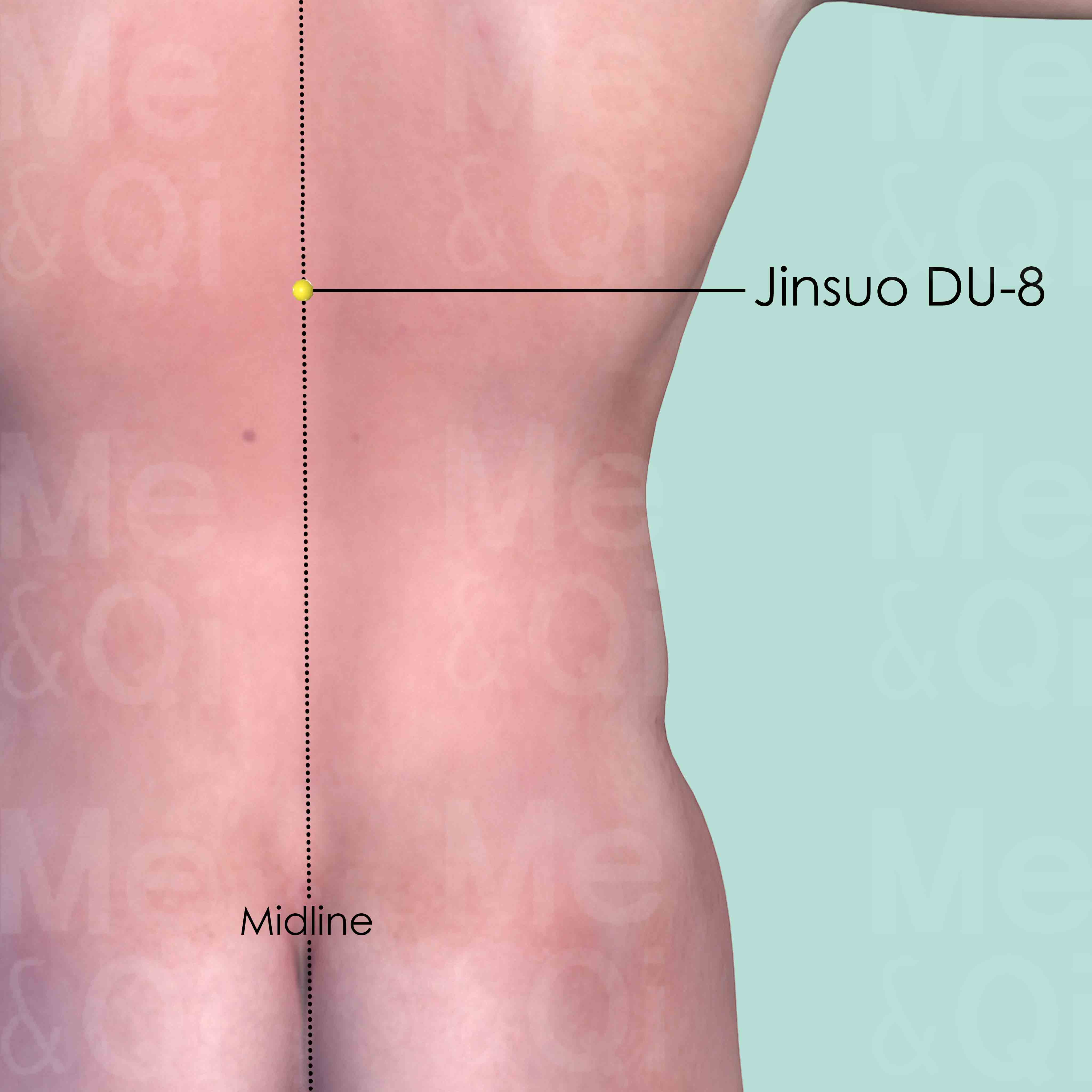
Jinsuo DU-8
On the back midline, in the depression below the spinous process of the 9th thoracic vertebra (T9).
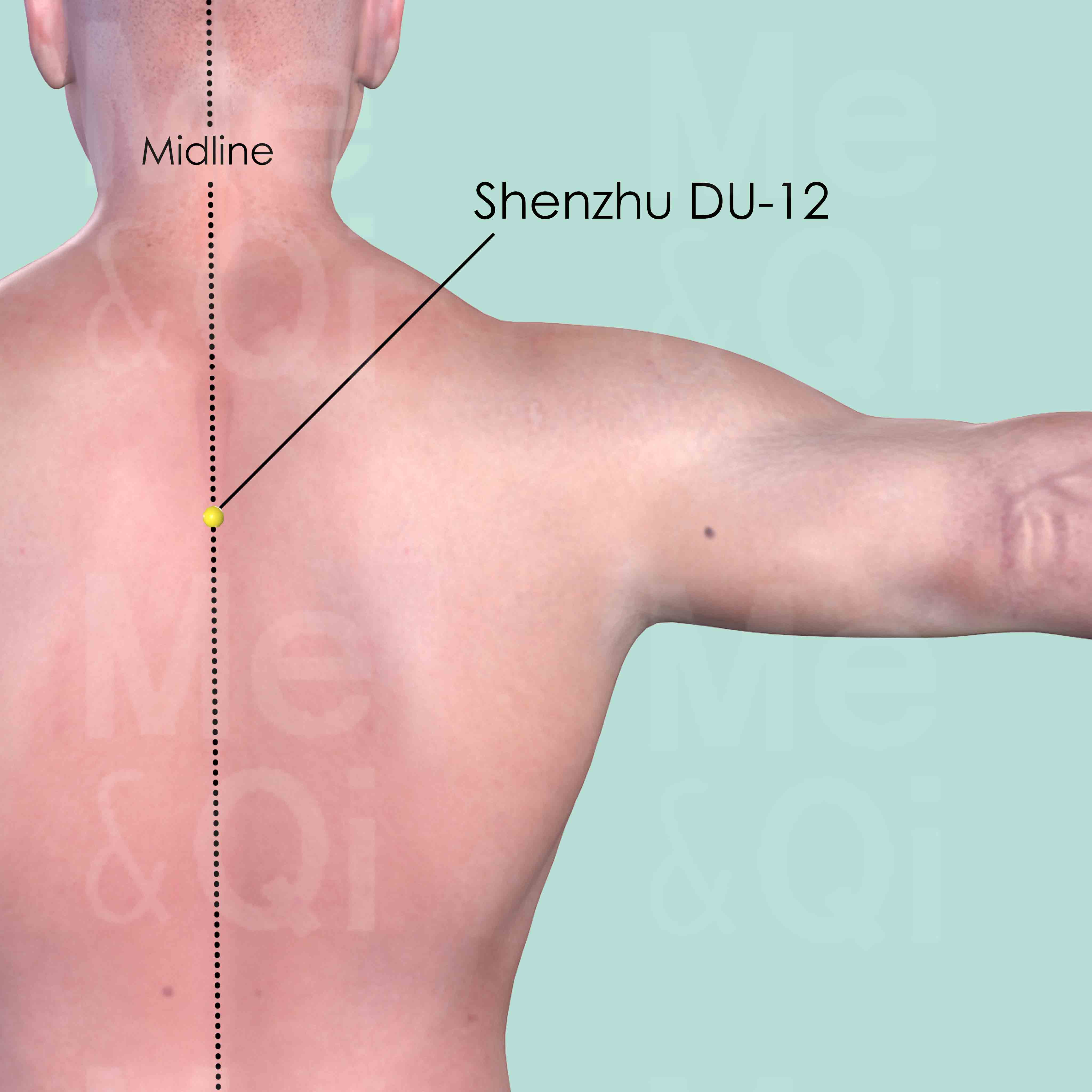
Shenzhu DU-12
On the back midline, in the depression below the spinous process of the 3th thoracic vertebra (T3).
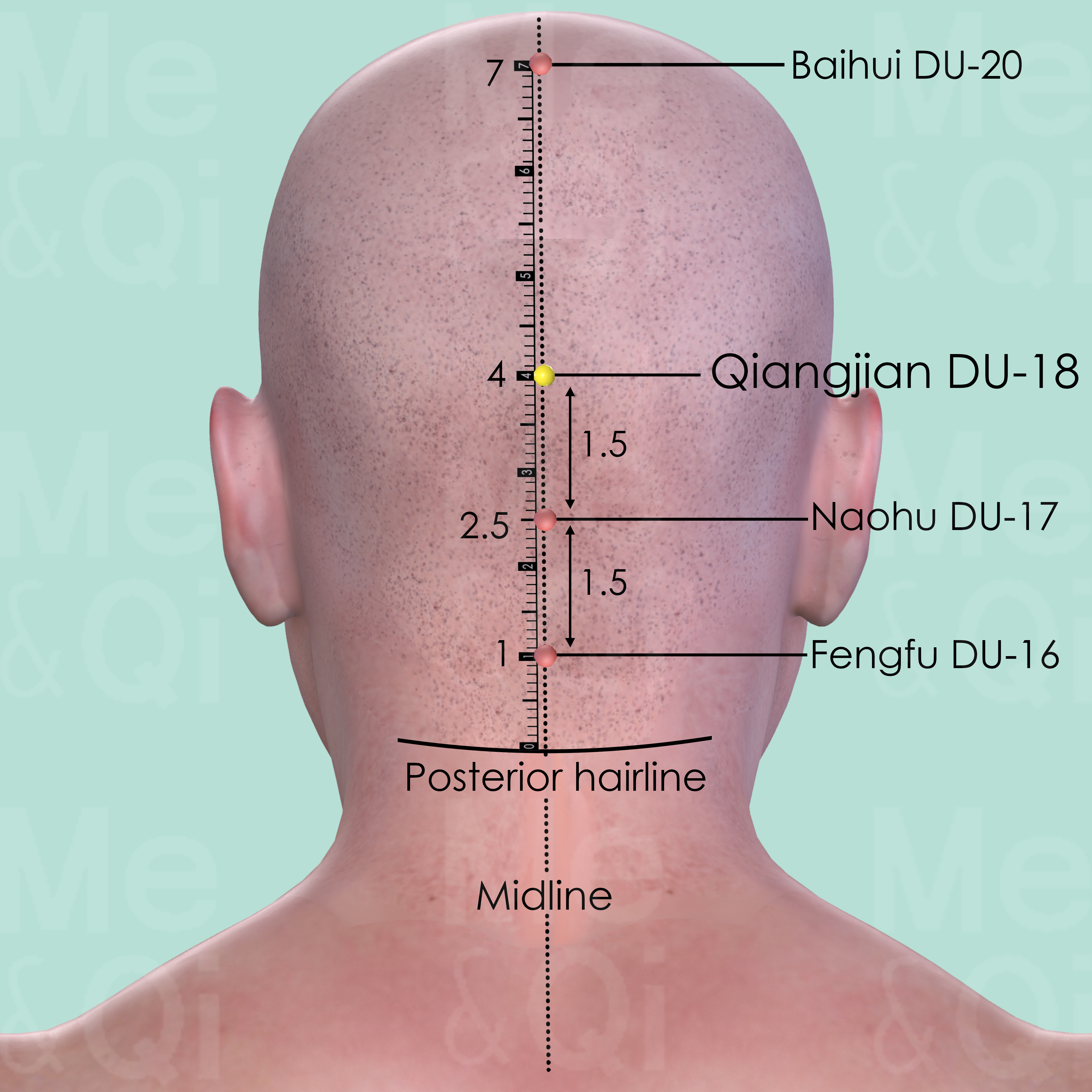
Qiangjian DU-18
On the posterior midline, 1.5 cun above Naohu DU-17, midway between Fengfu DU-16 and Baihui DU-20.
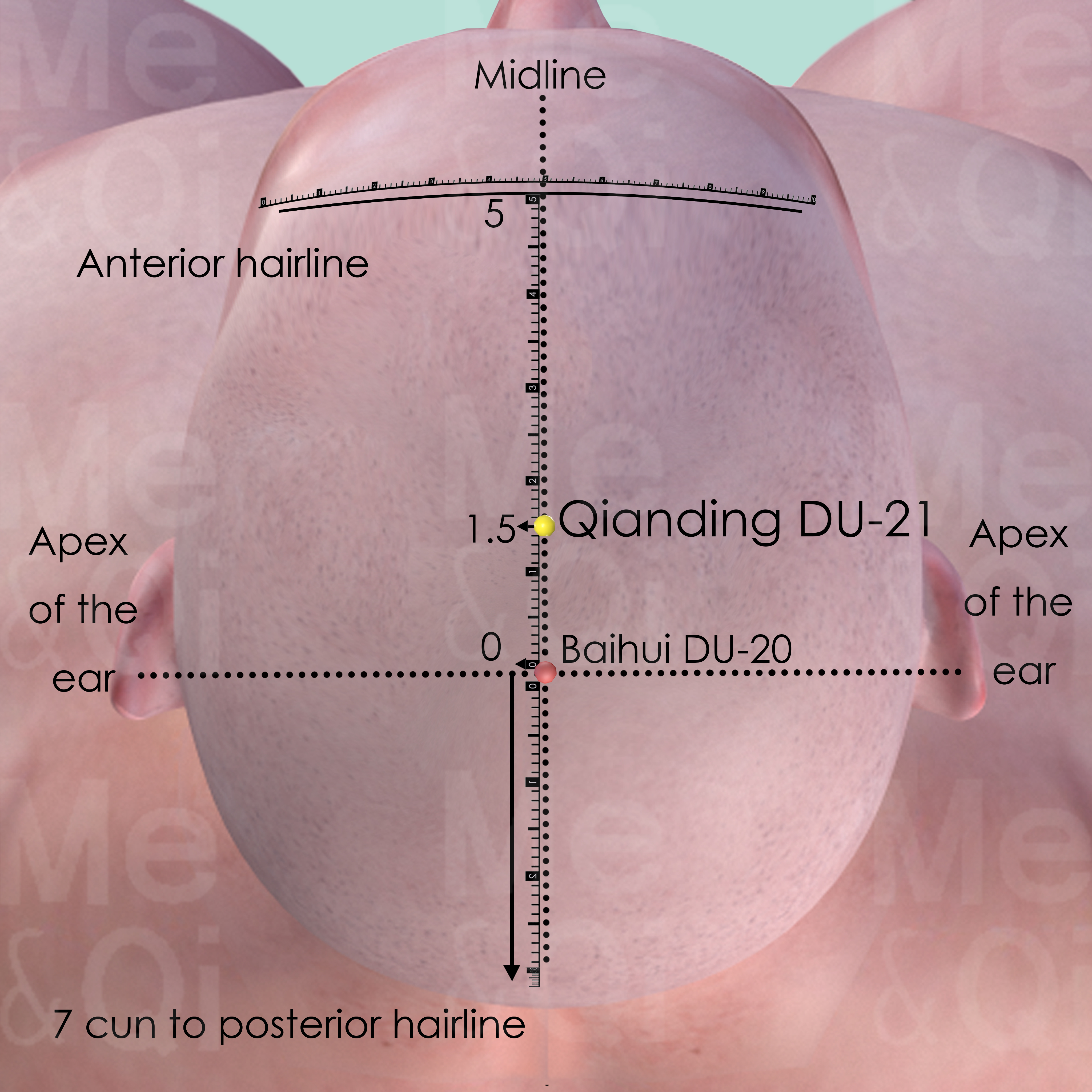
Qianding DU-21
On the midline, 1.5 cun anterior to Baihui DU-20 or 3.5 cun posterior to the anterior hairline.
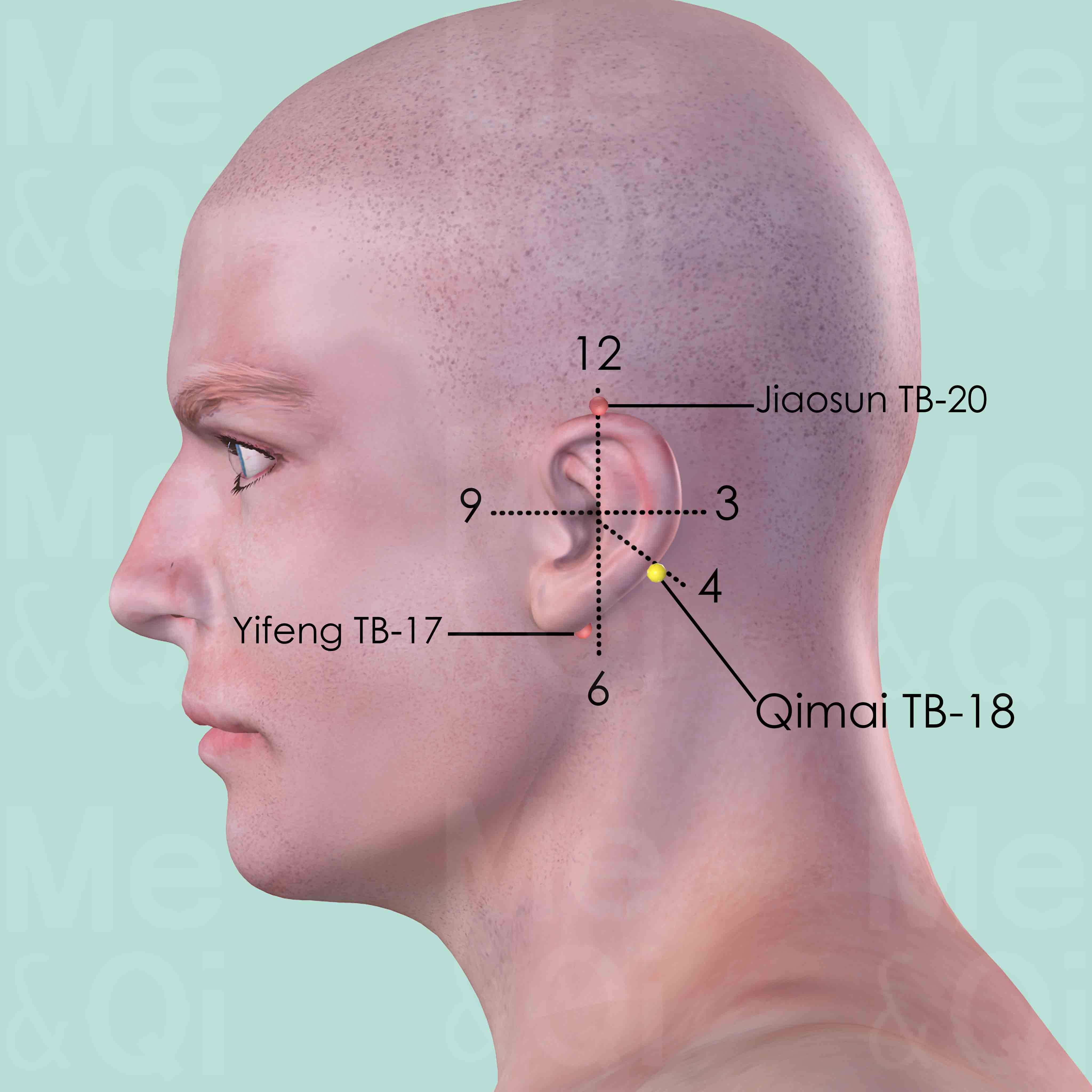
Qimai TB-18
In the center of the mastoid process, at the junction of the middle and lower third of the curve formed by Yifeng TB-17 and Jiaosun TB-20 posterior to the helix.
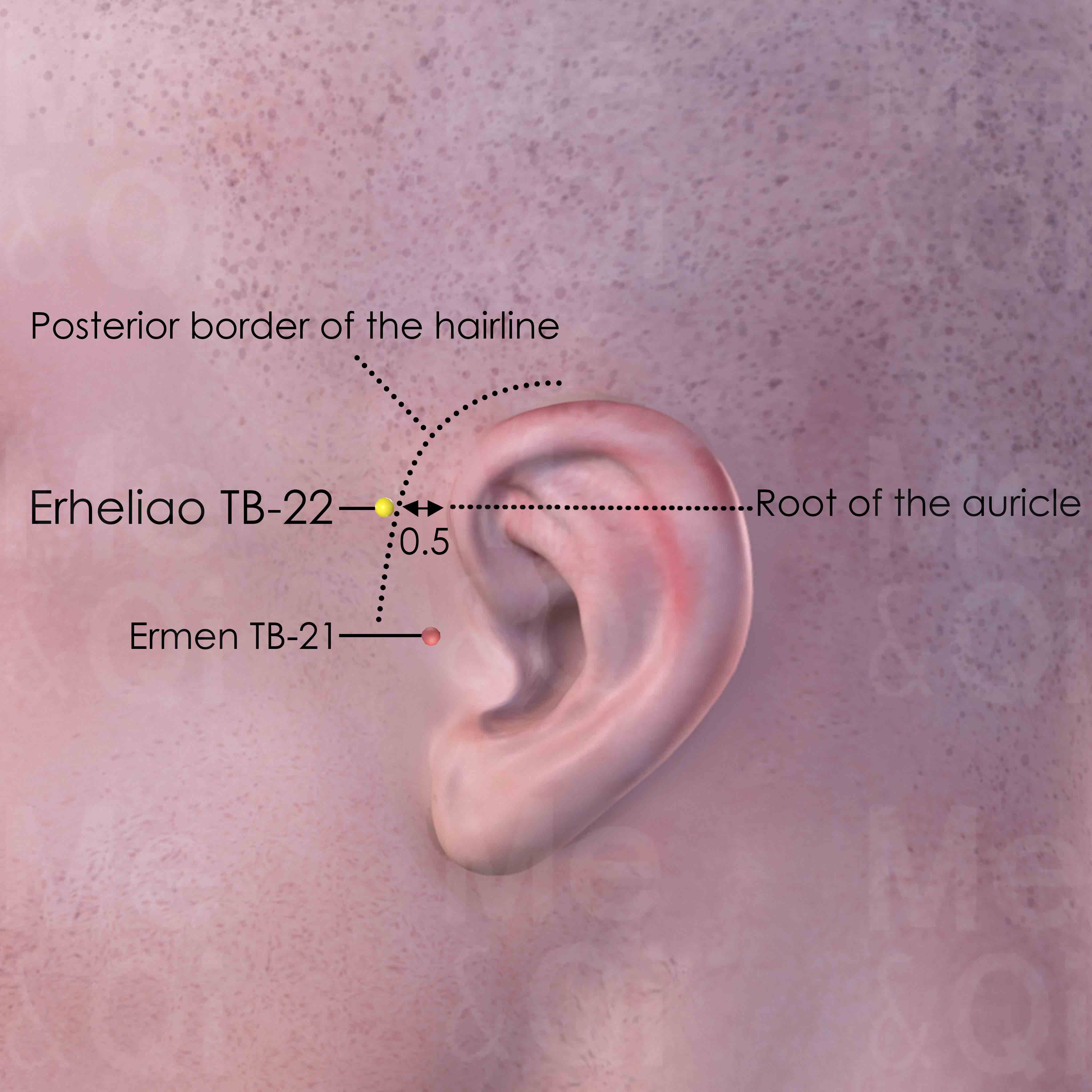
Erheliao TB-22
Anterior and superior to Ermen TB-21, level with the root of the auricle, on the posterior border of the hairline of the temple where the superficial temporal artery passes.
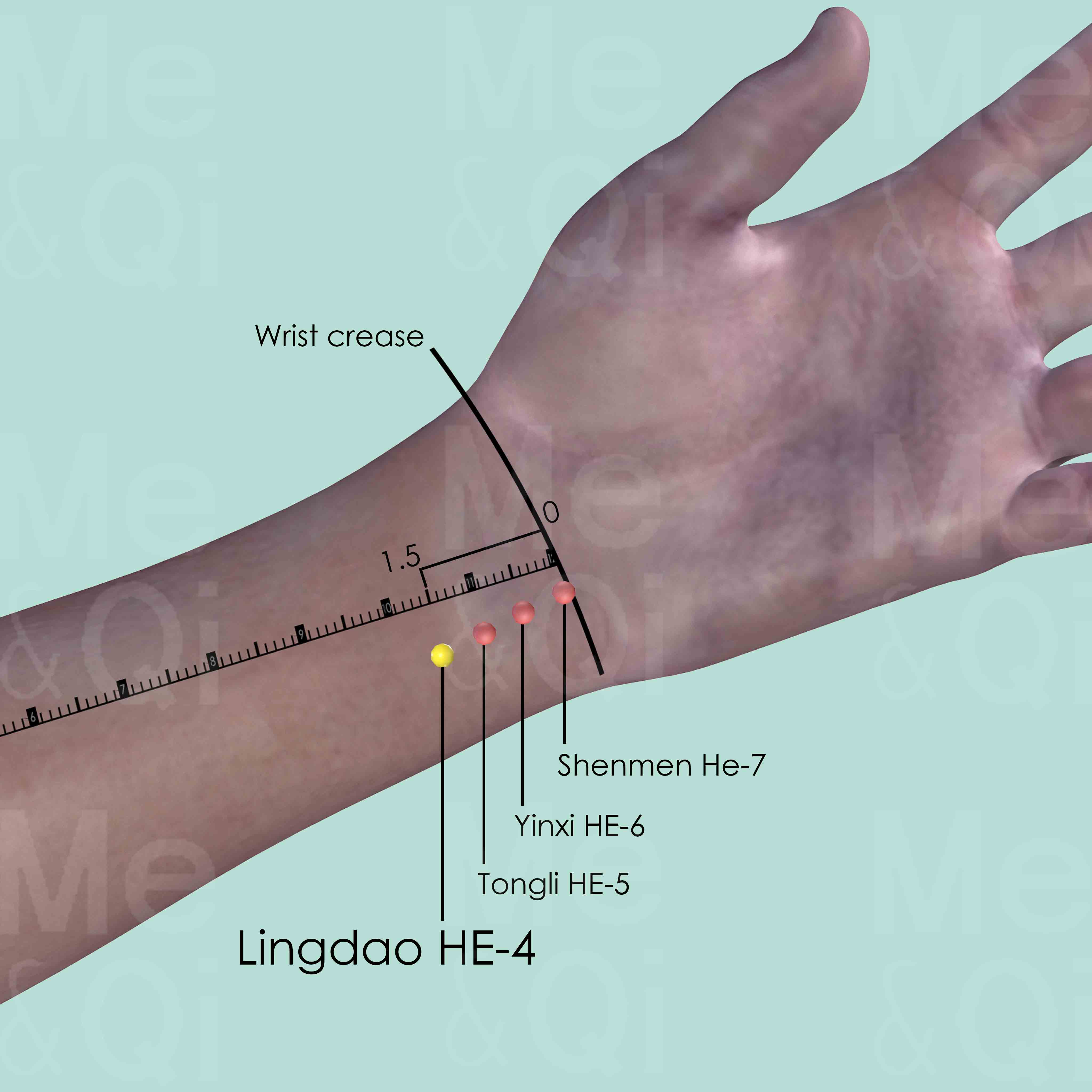
Lingdao HE-4
On the radial side of the tendon of flexor carpi ulnaris, 1.5 cun above the transverse crease of the wrist when the palm faces upward.
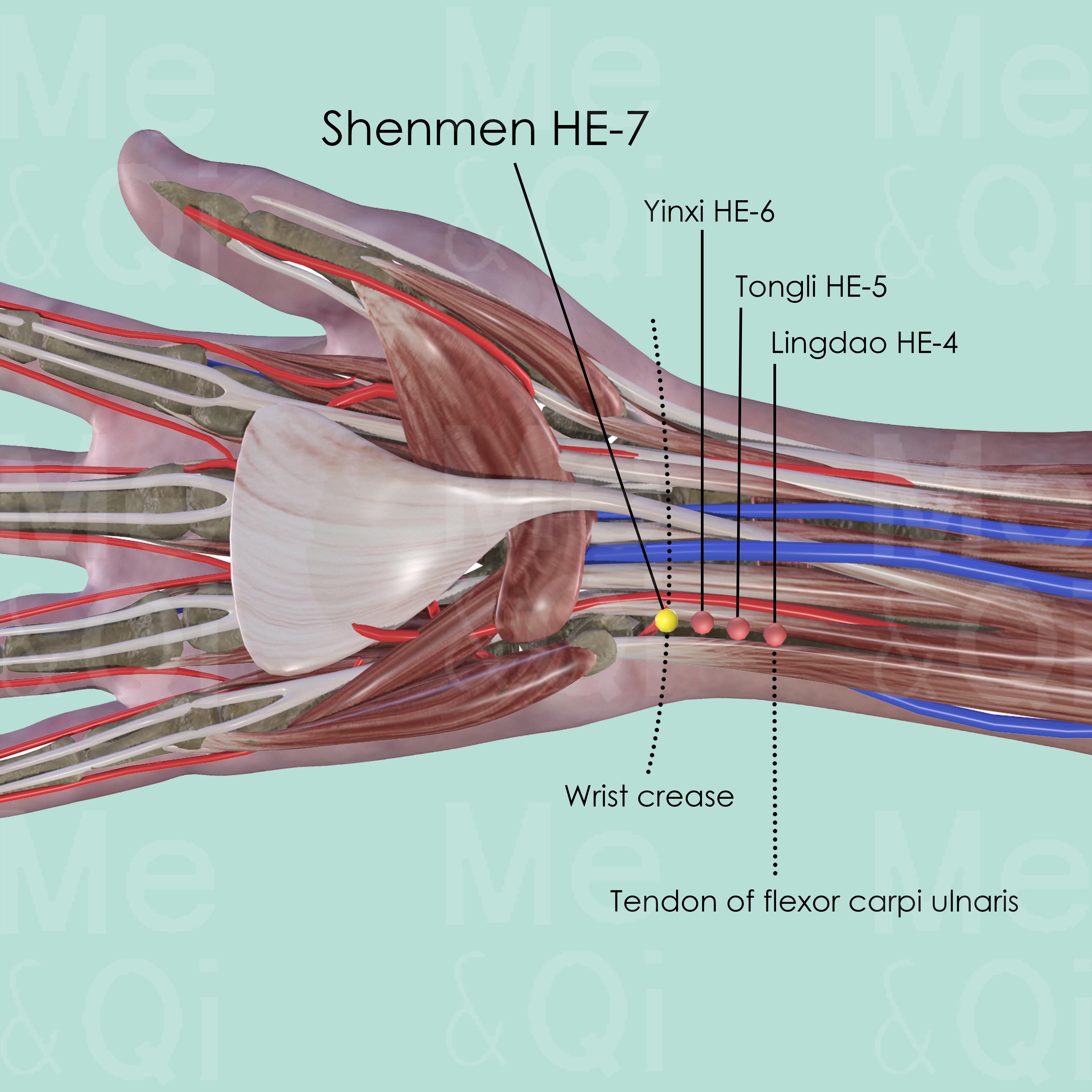
Shenmen HE-7
On the transverse crease of the wrist, in the articular region between the pisiform bone and the ulna, in the depression on the radial side of the tendon of flexor carpi ulnaris muscle.
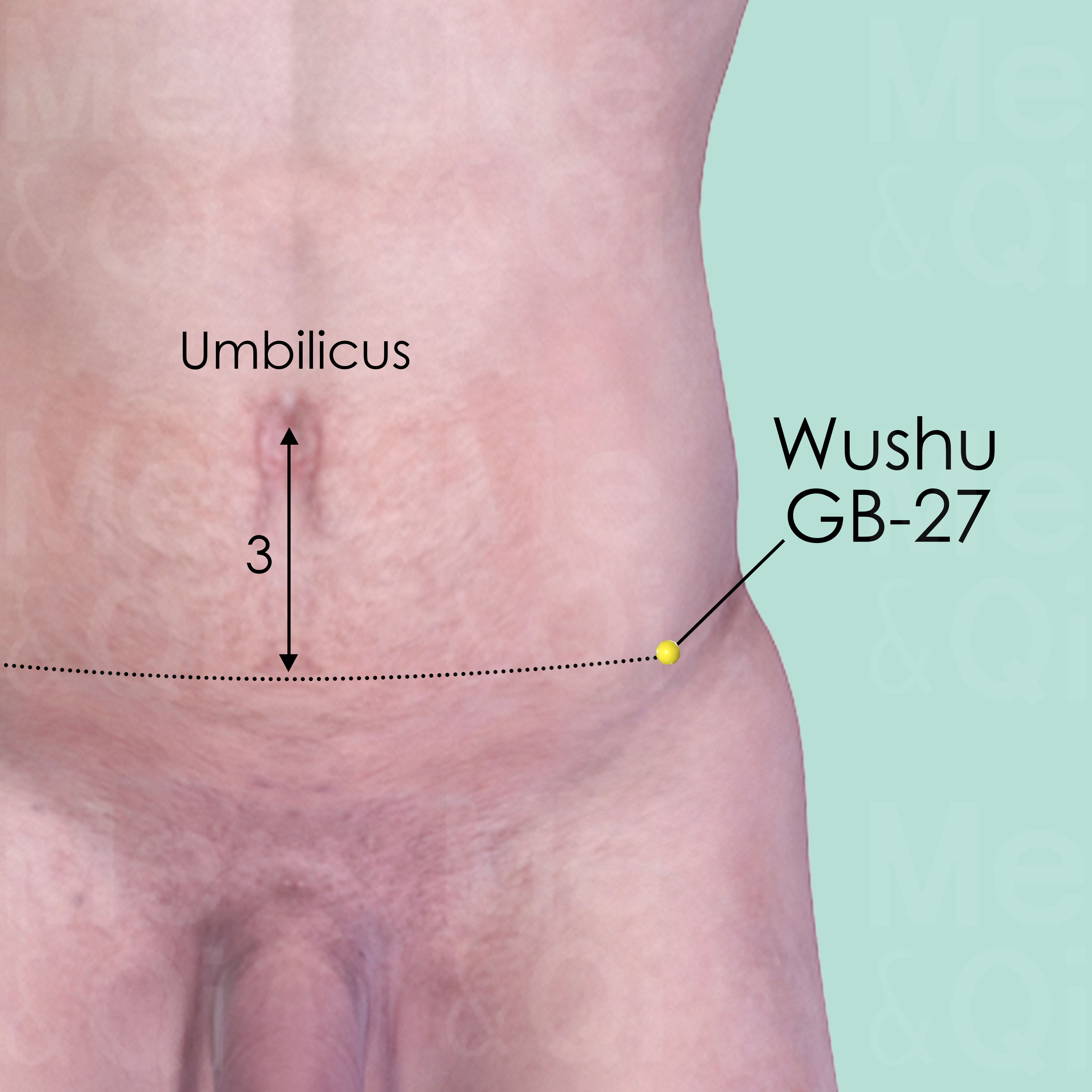
Wushu GB-27
In the lateral side of the abdomen, in the front of the anterior superior iliac spine (ASIS), 3 cun below the level of the umbilicus.
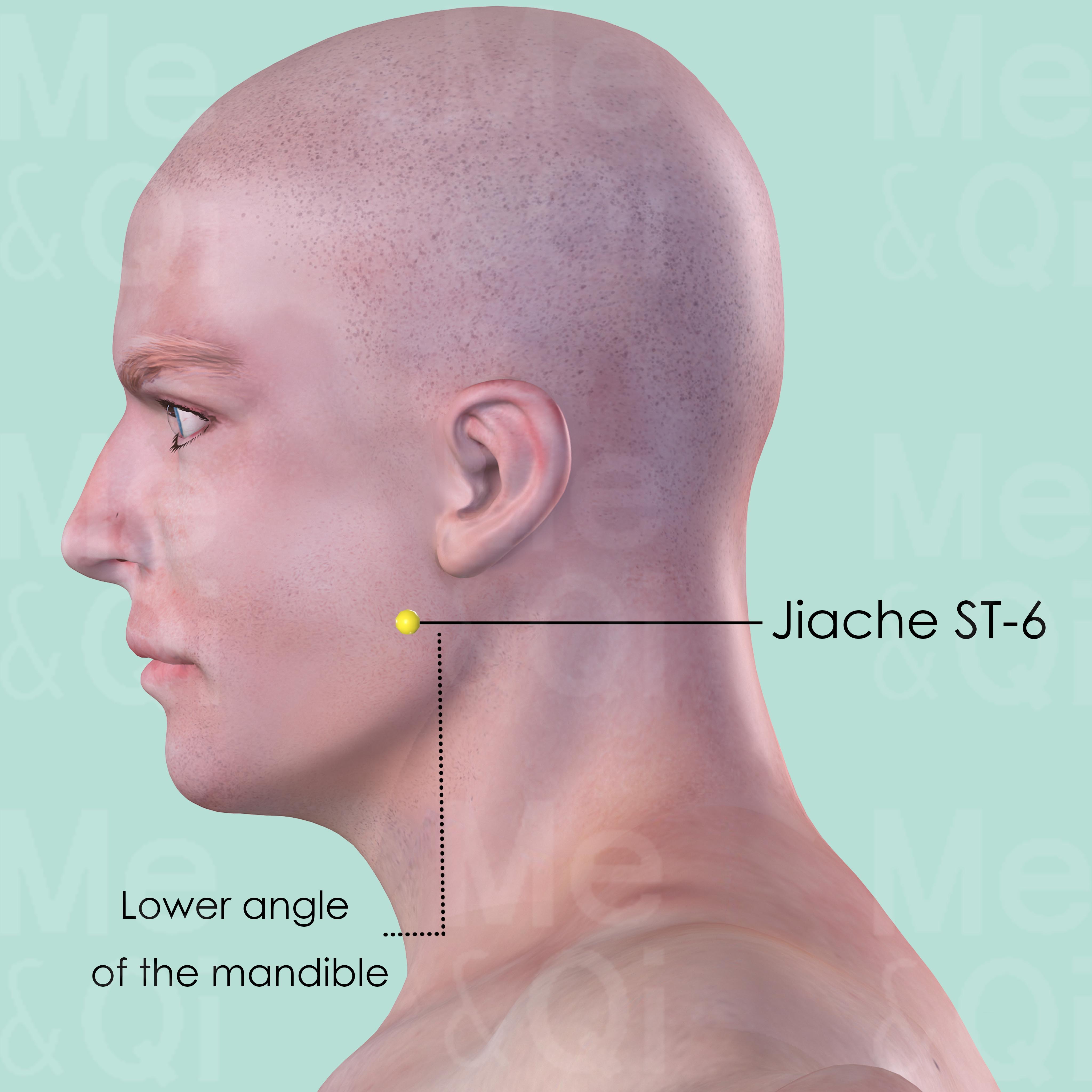
Jiache ST-6
One finger-breadth anterior and superior to the lower angle of the mandible where masseter muscle attaches at the prominence of the muscle when the teeth are clenched.
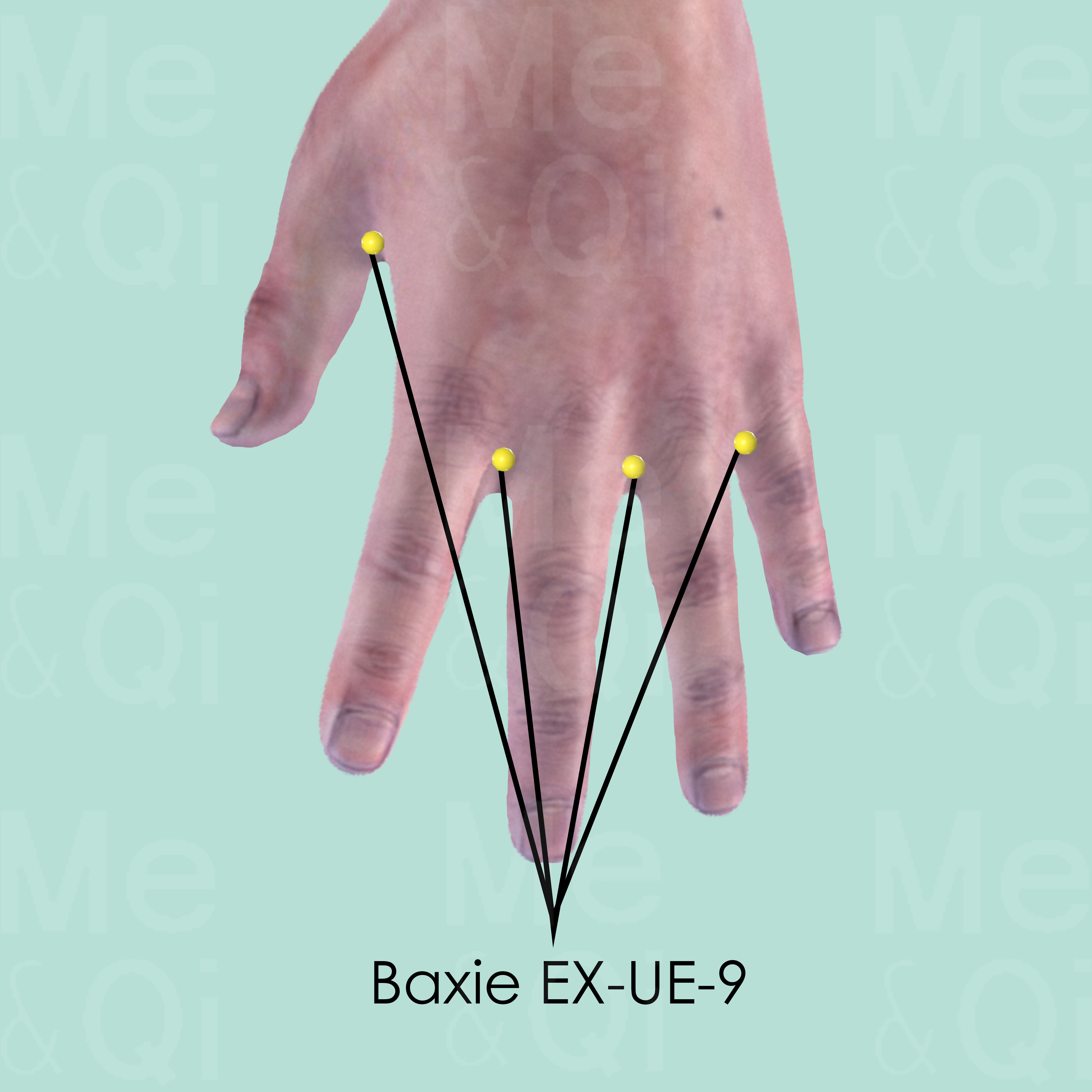
Baxie EX-UE-9
This is a group of 8 points in both hand, 4 points per each hand. Slightly proximal to the margins of the webs between the fingers, on the border of the red and white skin.
